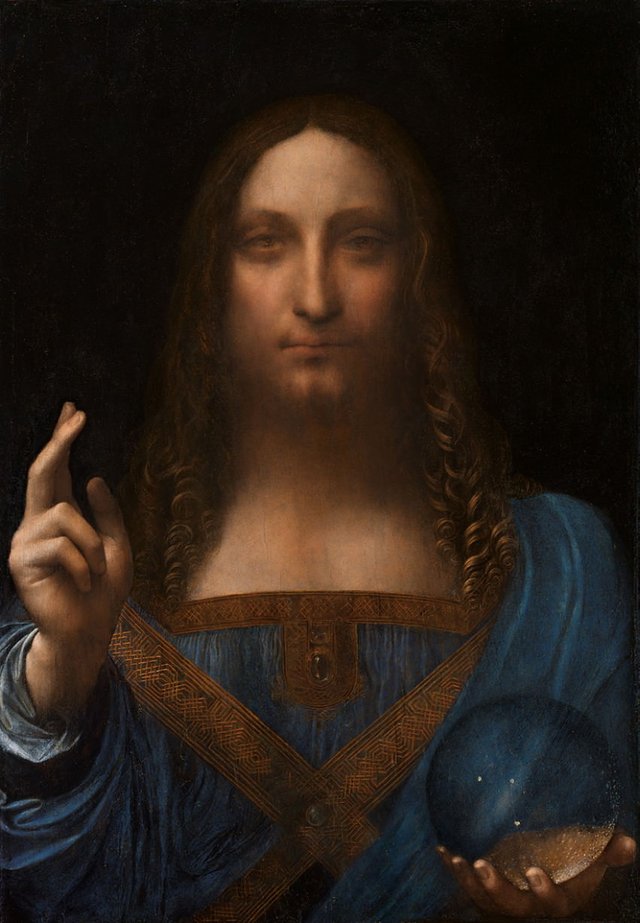Last week, a Leonardo daVinci painting sold at the prestigious Christie's auction house in New York for US $450.3 million, the highest price ever paid for a piece of art at auction. In the course of some seven minutes, the "Salvator Mundi" became one of the most expensive "things" ever traded.
A Change of Direction?

"Salvator Mundi" by Leonardo da Vinci
Source
On a personal (philosophical) level, this makes me happy because it was the sale of an "old master work," seemingly shattering the the previous stranglehold of record high art sales held by abstract and modernist painting. For some 50+ years, the art world has pretty much looked down its nose at traditional figurative work and even derisively labeled it "craft," and that has been reflected on prices at auction.
It was almost as if there was a wholesale rejection of art that demonstrated its maker having technical skill, as well as vision.
Does this represent a change of values? A movement toward something less abstract?
In his post "$450 Million Contemporary Art Butthurt" (published shortly after the sale took place), @leoplaw makes an excellent analysis, if you're interested in that end of the equation.
But that's not really what I want to look at, today.
How Do We "Value" Things?
I am more interested in looking at the "value" of things.

"Red Geranium"
Here we have a piece of art, obviously "valued" by someone at $450.3 million (winning bid of $400 million + auction commission). But let's add some perspective to this reality... because this was sold at public auction, there was also ANOTHER bidder who thought it was worth... $420 million? Or whatever the second highest bid was.
In fact, if you watch the live-action bidding embedded in the first article I link to, you'll see that there were at least 3-4 bidders involved till the price passed $250 million.
One quarter billion dollars.
But in assigning these "values," what does the new owner actually have?
Sure, they have "a piece of art" with a long documented provenance that includes royal families, but it begs the question of how much of that price is actually for the ART, and how much is for intangibles such as social status, bragging rights, establishing reputation, a personal sense of power, and whatever else is important to the extremely rich?
That part gets a lot harder to sort out.
Art... and Professional Sports
Part of what I end up looking at here is the remarkable similarity between art and professional sports.

"View Through a Leaf"
Even though Leonardo da Vinci is long dead, the art world is made up of a tiny handful of extreme superstars and an ocean of (mostly) starving contenders. It tends to be a field of huge inequities.
In sports, whether it's baseball player Alex Rodriguez being signed to the New York Yankees for $275 million or Brazilian soccer star Neymar going to Paris Saint Germain for $270 million, these heady prices tend to include a lot more than the actual value of the player, themselves.
And so it is, with the upper echelons of art. We end up in places where the value of the "bragging rights" of ownership far outrank the value of the "thing" that is being valued.
So What DO We Value?
Whereas the sale of the "Salvator Mundi" certainly ranks highly as an exciting event in the art world, it brings to mind questions of what we value, as a culture.
What does a single person paying $450 million for a single piece of art say... for example, in comparison to that figure representing more than 20% of the Gross Domestic Product of the Central African Republic... a nation with over four million people?
What does it say that this happens in a "highly developed" industrialized nation where 44 million people depend on food stamps to get by?
What do we VALUE? And WHY?
Thank you for reading! Red Dragonfly is a proud member of the @sndbox creative initiative.

The Red Dragonfly is an independent alternative art gallery located in Port Townsend, WA; showcasing edgy and unique contemporary art & handmade crafts by local and worldwide artists. All images are our own, unless otherwise credited. Where applicable, artist images used with permission.
I agree with your stance here and these are worthwhile questions to explore. I will say however that if some one thing is going to sell for that much, I'm glad it's a piece of art rather than something else like a car or a special iphone ;-). And even better that it's a Da Vinci since he represents the "renaissance man" which seems to be a rarely valued characteristic in these days of divided focus and instant gratification.
Downvoting a post can decrease pending rewards and make it less visible. Common reasons:
Submit
I totally agree with you on that... and I really appreciated the fact that we're dealing with a piece of "recognized art" with a long trackable provenance, not just "some pee stains on a sheet." I could easily wax philosophically on the widening gape between the "haves" and the "have-nots" but that's not a very popular discussion these days.
Downvoting a post can decrease pending rewards and make it less visible. Common reasons:
Submit
I think waxing about the haves and havenots is welcome on steemit! it's a direct contradiction to that paradigm so wax away ;-)
Downvoting a post can decrease pending rewards and make it less visible. Common reasons:
Submit
There is also the aspect of having 450 million worthless dollars. You know the dollar is going to crash soon, so buying something that other people value is a good place to park that wealth. The more people that bid on the art piece, the more those people feel they are getting a good parking place.
It seems to be the middle group of art "connoisseurs" who want the bragging rights. The ones who go to art gallery parties, and have to buy the latest from whom is at the top of the craze.
Then you have the bottom who go and buy lithographic prints with a few strokes of paint applied, for a ridiculous sum of money.
There are very few actual art loving / collecting people.
Downvoting a post can decrease pending rewards and make it less visible. Common reasons:
Submit
Among many other things that I might came later to say, meanwhile I concur a lot with the rationality of this comment. Thank you @builderofcastles for a well thought perspective about this issue. :)
Downvoting a post can decrease pending rewards and make it less visible. Common reasons:
Submit
You're definitely right that there are few genuine art lovers out there who simply collect art... and most of those who do tend to move in the ranks of lower priced artists.
I'm not sure if art is a good place to park "worthless dollars" although people seem to think so... but the upper end of art tends to have its own speculative bubbles based on what happens to be "popular" at any given time. What one could say in favor of the Leonardo painting is that at least it is a classic, not a trend.
Downvoting a post can decrease pending rewards and make it less visible. Common reasons:
Submit
Increased value in art, a focus on the 'superstars' in society, ( and chefs reaching superstar status, which I found interesting..) and a massive wealth gap
(from 'death of empires', if memory serves)
-All symptoms of the last gasp of air of a dying civilization - in the cycle of empires.
This is nothing new.
In fact, it is almost boring with it's predictability.
Art of this price is seen as somewhere to park your money, when the currency has no value ( or very soon, will have no value)
It has zero to do with art. Or value.
Downvoting a post can decrease pending rewards and make it less visible. Common reasons:
Submit
I would agree, and it definitely has very little to do with art.
For some decades, looking up to those who are merely successful has been supplanted by looking up only to superstars, in what seems to amount to more of a "lottery effect" than anything. More and more, getting to the upper echelons of society becomes dependent on "a stroke of luck" than on actual ingenuity and production of "something."
Not sure how far it has to go, but it's shades of "The Hunger Games," or "Elysium" in which a tiny elite minority "owns" the world and live in a bubble of luxury while everyone else lives in squalor. Funny how often these "science fiction" foreshadow an actual future....
Downvoting a post can decrease pending rewards and make it less visible. Common reasons:
Submit
What does it say that this happens in a "highly developed" industrialized nation where 44 million people depend on food stamps to get by?
nothing..that's irrelevant.
nice try at a guilt trip though...Isn't that a logical fallacy of some sort?
do I value it...not a bit.
but who ever bought it did.
there's a word for that I think
oh yeah
MARKET
Downvoting a post can decrease pending rewards and make it less visible. Common reasons:
Submit
A matter of personal values, perhaps?
I imagine that even in an entirely free, no-government market, values of individuals would still run the gamut from "I care for nothing but my own well-being" to "social justice look out for others."
Downvoting a post can decrease pending rewards and make it less visible. Common reasons:
Submit
the market defines personal values
same thing.
Downvoting a post can decrease pending rewards and make it less visible. Common reasons:
Submit
Surely it's personal values that defines the market....
The market is a product of people, not the other way around...
Downvoting a post can decrease pending rewards and make it less visible. Common reasons:
Submit
yup....markets..ALL markets are chaotic systems.
millions, billions even TRILLIONS of individual transactions because...
who the hell knows why?
It's an individual decision on the part of those who are MAKING those transactions..
Downvoting a post can decrease pending rewards and make it less visible. Common reasons:
Submit
Bringing light to the issue, great article !
Downvoting a post can decrease pending rewards and make it less visible. Common reasons:
Submit
Thanks!
Downvoting a post can decrease pending rewards and make it less visible. Common reasons:
Submit